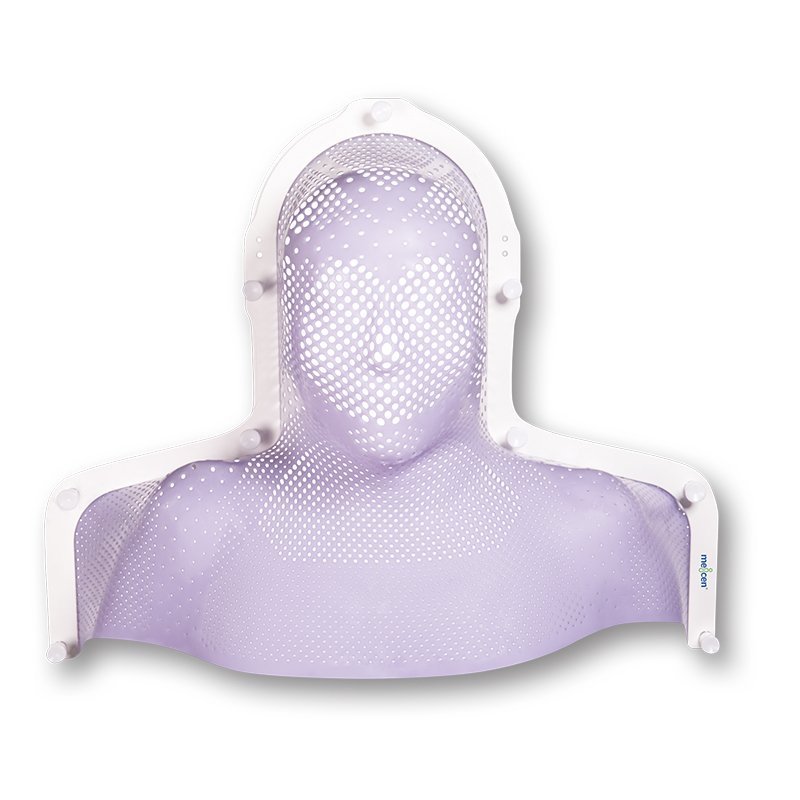About Radiation Mask: What patients should Expect
If the doctor has recommended radiation treatment (or radiotherapy) for cancer of the head, neck or brain, patients will likely need a custom-made radiation mask to wear during their treatments.

The purpose of the radiation mask is to hold your head and neck still and in exactly the right position during treatment. It helps us to deliver the radiation beam precisely to the tumor and limit damage to healthy tissues nearby. Now most of radiation masks are made with thermoplastic materials.
Before the Mask is Made:
It’s important to have a precise fit for each and every radiotherapy session. Once a mask is moulded, only slight adjustments can be made to it during the course of the treatment. Before the mask is fitted, patients should:
- Dental work
Before the radiotherapy mask is made, you may need to see a dentist to have your mouth and teeth checked. If some of your teeth are unhealthy, they may need to be removed or repaired. Dental work can change the shape of your mouth and face slightly. So, it is important this is done before the mask is made. - Mouth bites
Some people are given a mouth bite to wear inside their mouth during radiotherapy. This holds your mouth and jaw in position, so the right area is treated. This can also help reduce side effects. Your radiotherapy team will tell you if you need a mouth bite. If you do, you also need to wear it while your mask is made. - Hair
You do not usually need to have your hair cut before the mask is made. But if you have a beard, you should trim or shave it off. During your treatment, do not make big changes to your hairstyle or let your facial hair grow back. This can affect how well the mask fits. Wet shaving can irritate the skin during radiotherapy. Use an electric shaver if you need to shave.
Step 1: Making the Mask and Performing the Planning Simulation
Patients’ mask fitting will take about 30 minutes. The radiation therapy technologists will be with patients throughout this period to address any of their concerns or fears.
First, patient’ll remove any wig or head scarf, and put on a hospital gown. Then lie on a CT scan table and the technologist will help them get positioned comfortably. A sheet of gently-heated plastic mesh will be loosely draped over patient’s face and scalp,patient will still be able to see and breathe normally.
Next, the technologists gently stretch the mesh to conform to the shape of patient’s head, face and throat. The mask is then secured by clips on the table, and the patient will lie still for about 15 minutes, while the mesh cools and hardens. During this time, the patient will receive a planning CT scan with the mask on, to ensure that patient’s head remains still and in the proper treatment position and that his or her torso is in line with it’s neck.
Once the scan confirms that all measurements and positions are correct, the patient will receive a small permanent tattoo just below it’s neck. This mark will be used as a reference point to ensure that the patient’s body and mask are properly aligned for all future treatments. The mask will then be removed and stored at the hospital.
Step 2: The Treatment Planning
In the following days, the radiation oncologists, medical physicists and dosimetrists will work as a team to develop the best treatment plan for patient. Using a computer-generated 3D virtual model of patient’s planning CT scan, the team maps out patient’s tumor target area and normal tissues and determines the dose of energy to be delivered (how much, over how many treatments) to the patient’s tumor.
Step 3: The Verification Simulation
Once the treatment planning is complete, the patient will come in for a verification simulation. Also called a “dry run,” this is a trial run for treatment, but without radiation. For this, patient will lie on a treatment table and the mask will placed on patient. After checking the fit of patient’s mask and the positioning of its body, the technologists will take a set of images that verify precise starting points and coverage, to make sure that they are treating exactly the proper area, as determined by the doctor and planning team.
Step 4: The Treatments
The mask will be kept at hospital and the patient will wear it for each of its radiotherapy sessions. For most head, neck and brain cancer patients, radiation takes only about 10 minutes per session. But in some cases, a patient will have at least five weeks of radiation, five days a week.

